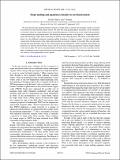Stripe melting and quantum criticality in correlated metals
Author(s)
Mross, David Fabian; Todadri, Senthil
DownloadMross-2012-Stripe melting and quantum criticality in correlated metals.pdf (1.285Mb)
PUBLISHER_POLICY
Publisher Policy
Article is made available in accordance with the publisher's policy and may be subject to US copyright law. Please refer to the publisher's site for terms of use.
Terms of use
Metadata
Show full item recordAbstract
We study theoretically quantum melting transitions of stripe order in a metallic environment, and the associated reconstruction of the electronic Fermi surface. We show that such quantum phase transitions can be continuous in situations where the stripe melting occurs by proliferating pairs of dislocations in the stripe order parameter without proliferating single dislocations. We develop an intuitive picture of such phases as “stripe loop metals” where the fluctuating stripes form closed loops of arbitrary size at long distances. We obtain a controlled critical theory of a few different continuous quantum melting transitions of stripes in metals. At such a (deconfined) critical point, the fluctuations of the stripe order parameter are strongly coupled, yet tractable. They also decouple dynamically from the Fermi surface. We calculate many universal properties of these quantum critical points. In particular, we find that the full Fermi surface and the associated Landau quasiparticles remain sharply defined at the critical point. We discuss the phenomenon of Fermi surface reconstruction across this transition and the effect of quantum critical stripe fluctuations on the superconducting instability. We study possible relevance of our results to several phenomena in the cuprates.
Date issued
2012-09Department
Massachusetts Institute of Technology. Department of PhysicsJournal
Physical Review B
Publisher
American Physical Society
Citation
Mross, David, and T. Senthil. “Stripe Melting and Quantum Criticality in Correlated Metals.” Physical Review B 86.11 (2012). ©2012 American Physical Society
Version: Final published version
ISSN
1098-0121
1550-235X